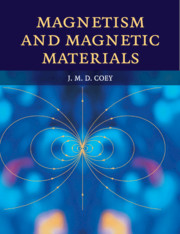Book contents
- Frontmatter
- Contents
- List of tables of numerical data
- Preface
- Acknowledgements
- 1 Introduction
- 2 Magnetostatics
- 3 Magnetism of electrons
- 4 Magnetism of localized electrons on the atom
- 5 Ferromagnetism and exchange
- 6 Antiferromagnetism and other magnetic order
- 7 Micromagnetism, domains and hysteresis
- 8 Nanoscale magnetism
- 9 Magnetic resonance
- 10 Experimental methods
- 11 Magnetic materials
- 12 Applications of soft magnets
- 13 Applications of hard magnets
- 14 Spin electronics and magnetic recording
- 15 Special topics
- Appendices
- Formula index
- Index
- Tables, conversions, constants and units
11 - Magnetic materials
Published online by Cambridge University Press: 05 June 2012
- Frontmatter
- Contents
- List of tables of numerical data
- Preface
- Acknowledgements
- 1 Introduction
- 2 Magnetostatics
- 3 Magnetism of electrons
- 4 Magnetism of localized electrons on the atom
- 5 Ferromagnetism and exchange
- 6 Antiferromagnetism and other magnetic order
- 7 Micromagnetism, domains and hysteresis
- 8 Nanoscale magnetism
- 9 Magnetic resonance
- 10 Experimental methods
- 11 Magnetic materials
- 12 Applications of soft magnets
- 13 Applications of hard magnets
- 14 Spin electronics and magnetic recording
- 15 Special topics
- Appendices
- Formula index
- Index
- Tables, conversions, constants and units
Summary
The keenest desire of matter is form
Almost all magnetically ordered materials involve 3d or 4 f elements. The late 3d metals and their alloys, including interstitial alloys and intermetallic compounds, are frequently ferromagnetic. Large magnetocrystalline anisotropy in 3d–4 f intermetallics, due mainly to the rare-earth, gives useful hard magnets. Conversely, the anisotropy can be reduced practically to zero in certain 3d alloys and, when magnetostriction is also vanishingly small, perfect soft ferromagnetism results. Oxides and other ionic compounds are usually insulators with localized electrons. There, antiferromagnetic superexchange coupling leads to antiferromagnetic or ferrimagnetic order. Some oxides, however, are metals, with the d-electrons forming a conduction band. Occasionally the 3d band is half-metallic. A few examples are included of materials showing magnetic order which involves neither 3d nor 4 f electrons.
Introduction
This chapter is a catalogue of representative magnetically ordered materials. The selection is biased towards materials that are practically useful, or illustrate some interesting aspect of magnetic order. Included are the common iron-group metals and alloys, the rare-earths, intermetallic and interstitial compounds, as well as a range of oxides with ferromagnetic or antiferromagnetic interactions. The catalogue covers insulators, semiconductors, semimetals and metals. Ferromagnetic, antiferromagnetic, ferrimagnetic and noncollinear spin structures are encountred. Examples of noncrystalline metals and insulators are also included. Table 11.1 collects information on the 38 representative materials. Each is described more fully on a data sheet, where its properties and significance are indicated, and related materials are presented.
- Type
- Chapter
- Information
- Magnetism and Magnetic Materials , pp. 374 - 438Publisher: Cambridge University PressPrint publication year: 2010
- 2
- Cited by

